Traditional Poster
Brain Networks & Vessels in fMRI & rs-fMRI
ISMRM & ISMRT Annual Meeting & Exhibition • 10-15 May 2025 • Honolulu, Hawai'i

 |
5185. MR
Functional Connectivity as an Effective Prognostic Biomarker for
Degree of PD Medication Reduction after DBS Parkinson’s Disease

D. Mikhael, S. Deutsch, J. Mehta, S. Wang, P. Starr, J.
Ostrem, D. Wang, I. Bledsoe, M. Morrison
University of California, San Francisco, San Francisco, United States
Impact: We show that pre-operative measures of
functional connectivity in motor regions relevant to
Parkinson’s disease mechanisms can explain differences in
patient response to deep brain stimulation (DBS). These
prognostic criteria can aid in filtering DBS candidates and
improve patient-centric outcomes.
|
|
 |
5186. High-Order
Gray-White Matter Connectivity in Hypergraph-based Brain Network
L. Xu, Y. Gao, M. Li, Z. Zu, Y. Li, K. Schilling, A.
Anderson, J. Gore, Z. Ding
Vanderbilt University Medical Center, Nashville, United States
Impact: This hypergraph framework provides a sensitive
tool to characterize AD-related functional deterioration in
WM-GM connectivity.
|
|
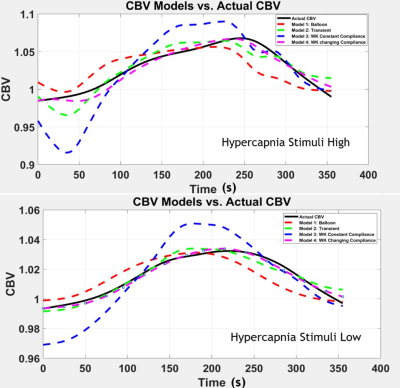 |
5187. The
dynamic relationship between cerebral blood flow and venous
cerebral blood volume under different types of stimuli
Y. Shafaee, G. Hartung, A. Berman
Carleton University, Ottawa, Canada
Impact: The
transient coupling of CBF and CBV is incompletely
understood, limiting the interpretation of BOLD dynamics and
quantitative measurements of brain physiology. We examined
and modelled the transient behaviour of CBF and venous CBV
during a range of tasks.
|
|
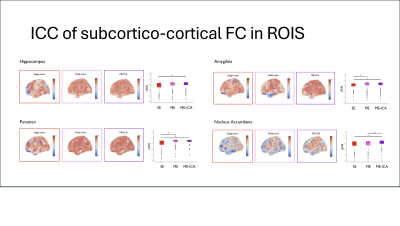 |
5188. Reliable
Measurement of Cortico-subcortical Functional Connectivity of
Human Brain with 7T MRI
N. CROSS, J. Chen, H. Wang, S. Naismith, F. Calamante, Z.
Chen, J. Lv
The University of Sydney, Camperdown, Australia
Impact: This multi-echo fMRI sequence demonstrates a
significant boost in signal quality from subcortical regions
that suffer from degradation in single-echo sequences. This
robustly increases reliability of FC estimates when
investigating the roles of subcortex in cognition and
disease (e.g. neurodegeneration).
|
|
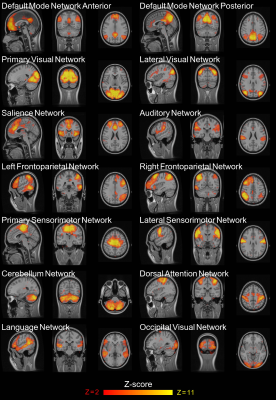 |
5189. A
causal modelling of the brain as a network of networks: a
comparison between autism and controls
S. Schielen, D. Stepanov, J. Pilmeyer, D. Ruijters, A.
Aldenkamp, S. Zinger
Eindhoven University of Technology, Eindhoven, Netherlands
Impact: The causal modelling of resting-state networks
gives insight into the brain’s effective architecture as a
network of networks. Where autists deviate from this typical
architecture can relate to autism’s pathophysiology and
motivates research, e.g., into diagnostic or prognostic
relevance.
|
|
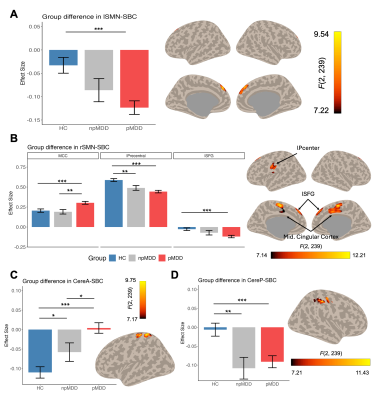 |
5190. Functional
Connectivity Alterations Underlying Psychomotor Disturbances in
Major Depressive Disorder
Q. Liang, Z. Zhou, Y. Li, S. Chen, S. Lin, X. Lin, Y. Zhang,
B. Peng, Z. Xu, X. Zhao, G. Hou, Y. Qiu
Shenzhen Nanshan distinct people's hospital, Shenzhen, China
Impact: This study advances understanding of the neural
basis underlying PsyD in MDD, provide evidence for the role
of dopaminergic dysregulation, and inform potential
diagnostic and therapeutic approaches targeting
neurotransmitter-related connectivity abnormalities in
affective disorders.
|
|
 |
5191. Resting-state
fMRI at 1.5T, 3T, and 7T: comparison of functional networks from
data-driven Independent Component Analysis
P. Ambrosi, M. Lancione, G. Donatelli, D. Montanaro, M.
Tosetti, L. Biagi
IRCCS Stella Maris, Calambrone (PI), Italy
Impact: This study compares resting-state BOLD-fMRI at
1.5T, 3T, and 7T, showing increased inter-subject similarity
of brain networks at higher field strength. Only 7T reliably
identified networks in all participants, suggesting greater
reliability at ultra-high field strength.
|
|
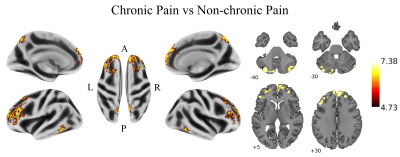 |
5192. Pain
chronicity, severity, and widespreadness are related to
increased rsfMRI-based Brain Entropy in the Prefrontal cortex
G. Del Mauro, Y. Li, J. Yu, P. Kochunov, L. Sevel, J.
Boissoneault, S. Chen, Z. Wang
University of Maryland School of Medicine, Baltimore, United States
Impact: Brain Entropy, as a measure of the randomness
and irregularity of brain activity, may represent a
neuroimaging-based biomarker for chronic pain. Brain Entropy
is modifiable through non-invasive brain stimulation, aiding
its potential translational value in the treatment of
chronic pain
|
|
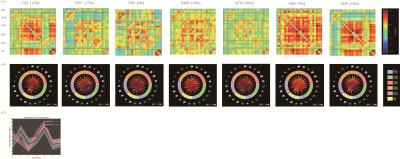 |
5193. Dynamic
Functional Network Connectivity Study Based on rs-fMRI in
Patients with Primary Hypothyroidism
q. zou, L. Zhao
The First Clinical Medical College of Gansu University of Chinese Medicine ( Gansu Provincial Hospit, Lanzhou, China
Impact: This study provides new insights into how
hypothyroidism alters the temporal dynamics of brain
connectivity, enhancing our understanding of its
neurobiological impact and potentially informing targeted
interventions to mitigate cognitive decline in affected
individuals.
|
|
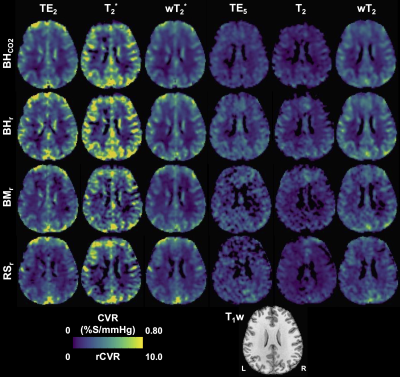 |
5194. Repeatability
and reliability of cerebrovascular reactivity in young adults
using multi-echo, multi-contrast MRI
E. Keeling, M. Bergamino, L. Ott, M. McElvogue, A. Stokes
Barrow Neurological Institute, Phoenix, United States
Impact: SAGE-fMRI improves repeatability and reliability
of CVR, increasing feasibility of CVR evaluation in patient
populations. SAGE-fMRI offers complementary CVR assessments
on total and microvascular scales, where a robust
microvascular-weighted analysis may be relevant to the study
of many neurovascular diseases.
|
|
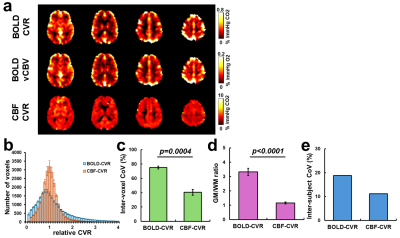 |
5195. Normalized
cerebrovascular reactivity mapping using hypercapnia and
hyperoxia challenges
E. Karimigharighi, F. Badrzadeh, H. Lu, P. Liu
University of Maryland School of Medicine, Baltimore, Baltimore, United States
Impact: The normalized CVR approach, using hypercapnia
and hyperoxia challenges with BOLD acquisition to obtain
CBF-CVR, can provide a more direct index of the
microvascular function and would be practical and promising
in clinical applications of cerebrovascular diseases.
|
|
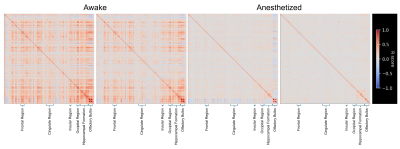 |
5196. Functional
Connectivity Differences in Mice Scanned Awake and Anesthetized
in the Same Imaging Session
S. Laxer, A. Eed, M. Bellyou, P. Zeman, K. Gilbert, R. Menon
Western University, London, Canada
Impact: Despite recent literature indicating the
negative effects of anesthesia on mouse fMRI, it is still
widely used. The current work demonstrates that functional
connectivity differences can be identified at the
single-subject level.
|
|
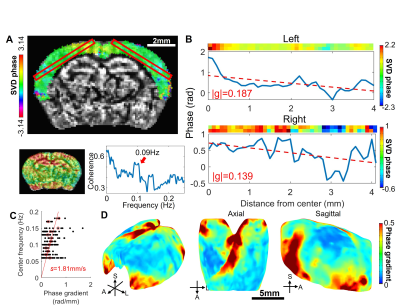 |
5197. Detecting
vasomotion of awake mice with 14T CBV fMRI
X. Liu, D. Hike, X. Zhou, X. Yu
Massachusetts General Hospital, Charlestown, United States
Impact: We applied high-resolution CBV fMRI to identify
vasomotion-related spatial coherence patterns in awake mice.
Bandwidth-specific phase gradient analysis presents a ~2mm/s
propagation wave across the cortex.
|
|
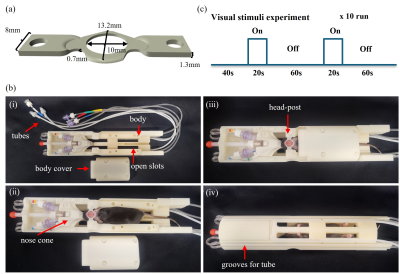 |
5198. The
mouse cradle minimizes head motion in awake fMRI at 15.2T
without habituation
S. Choi, G. H. Im, C-H Lee, S-G Kim
Institute for Basic Science, Yuseong-gu, Korea, Republic of
Impact: We have developed and validated a
head-motion-minimized cradle setup that enables awake mouse
fMRI without pre-training. The proposed cradle setup reduces
the effort required to minimize head motion for conducting
awake mouse fMRI experiments.
|
|
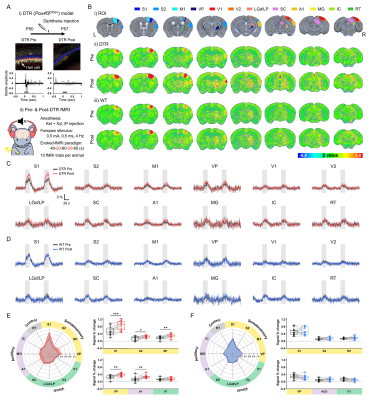 |
5199. Brain-wide
functional mapping reveals deafening-induced cross-modal
plasticity in mice
W. B. Jung, H-J Shim, G. H. Im, S. Lee, G. Kim, S-G Kim
Korea Brain Research Institute (KBRI), Daegu, Korea, Republic of
Impact:
Our findings suggest that sensory deprivation can drive extensive functional reorganization, even in adulthood. Brain-wide functional imaging provides a powerful tool to reveal the scope and underlying mechanisms of cross-modal plasticity. |
The International Society for Magnetic Resonance in Medicine is accredited by the Accreditation Council for Continuing Medical Education to provide continuing medical education for physicians.